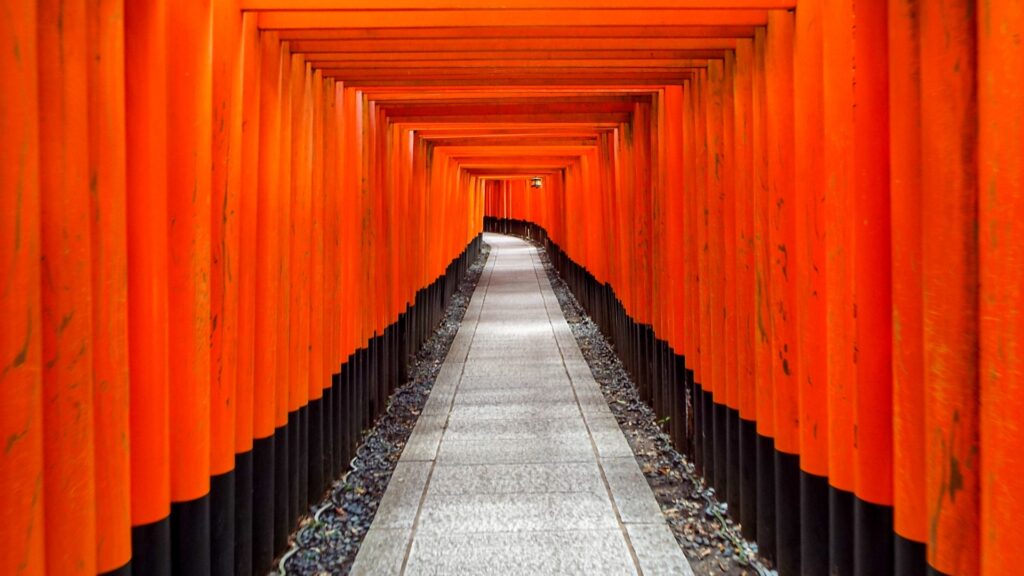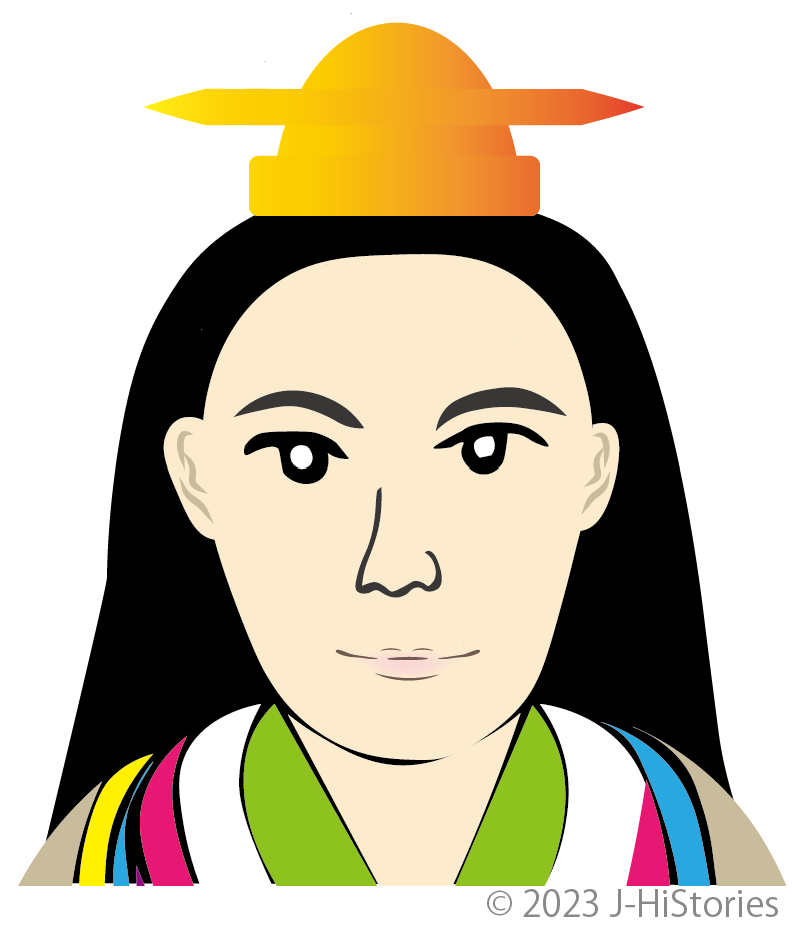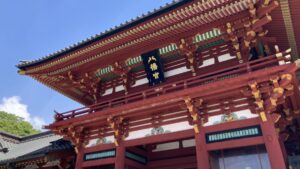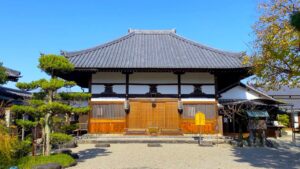Fushimi Inari Taisha Shrine, 5,000 vermillion torii gates
Fushimi Inari Taisha Shrine is one of the most notable Shinto shrines located at the foot of Mount Inari, which is considered sacred as a whole, in southern Kyoto. It is the head of over 30,000 Inari shrines across the nation that are prayed to for a good harvest. A grain deity named Ukano-mitama, also known as Oinari-san, is enshrined there. Hiking through the vermilion gates to the top allows you to experience the religious faith of the people and a sense of awe. In 711, the 43rd Female Emperor Genmei (660-771, 元明天皇) ordered the construction of the shrine to bless the harvest to Hata-no-Irogu of Hata Clan.

Female Emperor Genmei’s Wish to Pacify the Natural Disasters

Genmei experienced two grim events at the age of 3 and 12. Firstly, her father, Emperor Tenji (626-672, 天智天皇) suffered a crushing defeat in the Battle of Baekgang against the allied Tang dynasty and Silla, causing the verge of national annihilation. Secondly, her father-in-law, Prince Oama, later Emperor Temmu (?-686, 天武天皇), brought about the largest Jinshin War about Imperial succession against Prince Otomo in ancient Japan. When she was 18 years old, her husband, Prince Kusakabe, died young. Eighteen years later, her son, the 42nd Emperor Monmu (683~707, 文武天皇), passed away out of sheer frustration at the age of only 25 due to poor harvest caused by heavy droughts, strong winds, a plague of locusts, and also an epidemic nationwide. How much did Genmei wish to pacify the natural disasters? In vain, the unstable weather continued, and the long rain affected the rice crop. Despite this, Genmei ascended the throne in 707 at the age of 42, aiming for a better harvest. To achieve this, she ordered the establishment of a shrine in 711 at the foot of Mt. Inari, which was believed to be where a grain deity dwelled.
Blessing the Harvest to a Grain Deity, Ukano-mitama

The vermillion color and the fox played essential roles in ensuring a bountiful harvest. The vermillion color was believed to purify impurities as it symbolizes fire, while the fox is considered a divine messenger to the grain deity and represents the earth due to its sunny yellow hair. According to the Inyo Gogyo Theory (the theory of five elements in Yin-Yang*), fire generates ash (or earth) by burning wood. This means that the vermillion torii gates energize the power of the earth (represented by the fox), bringing about a harvest by Ukano-mitama's blessing (source: Kitsune or fox by Hiroko Yoshino, ISBN4-588-20391-6).
(*) Yin-Yang Theory is a philosophy that all activities consist of cycles of five elements; wood, fire, earth, metal, and water
Genmei Strove to Establish a National System without a Break
The accomplishments of Female Emperor Genmei in governing Japan included the construction of the Heijo-kyo Palace in 708, her move there in 710, the development of a nationwide transportation network, the introduction of a new copper coin called Wado-kaichin to stimulate the national economy in 709, and the appointment of a Shogun to conquer the Emishi. Thus, pretty large-scale construction work demanded severe labor service and many people had no choice but to escape from the starkness. During the construction of the Heijo-kyo Palace, a large-scale project that demanded severe labor service, many people had no choice but to escape the hardship. Despite this, she remained resolute and said, 'The food of the laborers runs out, many people are hungry, some tumble into ditches and crouches. If anyone dies, bury them' (Idiomatic translation of Shoku Nihongi - The Second Chronicles of Japan). Her energy did not wane. In 712, she oversaw the completion of the compilation of Kojiki (The Records of Ancient Matters), and in 713, she ordered the compilation of regional topography called 'Fudoki,' which aimed to summarize each provincial culture and oral tradition. While establishing the national system, Fushimi Inari Shrine became a center of prayer to the deity for the harvest. Female Emperor Genmei devoted herself to these tasks with a resolute will during the eight years of her reign. In 715, after the completion of her duties, she abdicated the throne to her daughter
The Vermilion Torii gates and Foxes are Proof of Genmei's Prayers for the Peace of People

Enjoy hiking through the seemingly endless vermilion gates of Fushimi Inari-Taisha Shrine while reflecting on the turbulent life and accomplishments of Female Emperor Genmei. As a true stateswoman, she was perhaps the first emperor to view Japan as a single unified nation and state encompassing the entire archipelago, from the Tohoku region to Kyushu. While previous emperors were also aware of the concept of a nation, their national boundaries seemed to be limited to the Nara to Kyushu region at most. Female Emperor Genmei was known for her compassion and consideration for her people. She prayed to Ukano-mitama, the deity of grain, for a bountiful harvest to prevent her people from starving. It is said that the fox statues at Fushimi Inari brought about the successful harvest, which is why they are enshrined there along with the vermillion torii gates. Wishing for the prosperity of the nation and the well-being of its people is an essential duty of an emperor
Emperor Genmei Timeline
| 661 | Genmei was born | Age =1 | Asuka period |
| 663 | The Battle of Baekgang | 3 | |
| 672 | Jinshin War | 11 | |
| 673 | Emperor Tenmu ascended the throne | 12 | |
| 680 | Genmei married Prince Kusakabe at latest before 680 | 19 | |
| 683 | Genmei gave birth to Prince Karu (later Emperor Monmu) | 22 | |
| 686 | Emperor Tenmu passed away | 25 | |
| 689 | Prince Kusakabe passed away | 28 | |
| 690 | Female Emperor Jito ascended the throne | 29 | |
| 694 | The capital was moved to Fujiwarakyo in northwest of Asuka | 33 | |
| 697 | Emperor Monmu ascended the throne | 36 | |
| 701 | Taiho Code was completed | 40 | |
| 702 | Female Emperor Jito passed away | 41 | |
| 704-706 | Natural disasters often occurred | 43-45 | |
| 707 | Emperor Monmu passed away | 46 | |
| 708 | Wado-kaichin (copper coin) was developed | 47 | |
| 708 | Proclamation of the transfer of the capital to Heijo-kyo | 47 | |
| 709 | Appointment of a general to conquer Emishi | 48 | |
| 710 | Relocation of the capital to Heijo-kyo in Nara from Asuka | 49 | Nara period |
| 711 | Establishment of Fushimi Inari-Taisha Shrine | 50 | |
| 712 | Compilation of Kojiki | 51 | |
| 713 | Compilation of Fudoki | 52 | |
| 715 | Female Emperor Genmei abdicated the throne to her daughter, Gensho | 54 | |
| 715 | Female Emperor Gensho ascended the throne | 54 | |
| 721 | Female Emperor Genmei passed away | 60 |
Recommendations to visit
Fushimi Inari-Taisha Shrine
- Access: 5 minutes from JR Kyoto Station on JR Nara Line to Inari Station. Then a one-minute walk.
Kasama Inari Jinja Shrine
- Access: 1.5 hours from Tokyo Station on JR Joban Line to Tomobe Station. Take the ”Kasama Tour Bus” at Kasama Station North Exit. Got off at the "Inari Shrine (稲荷神社)" bus stop. (20 minutes trip). Then a 3-minute walk.
Toyokawa Inari Shrine
- Access: 1 hour from Nagoya Station on Meitesu Main Line to Ko Station, then transfer on Toyokawa Line bound for Toyokawa Inari Station. Then, a 5-minute walk.


